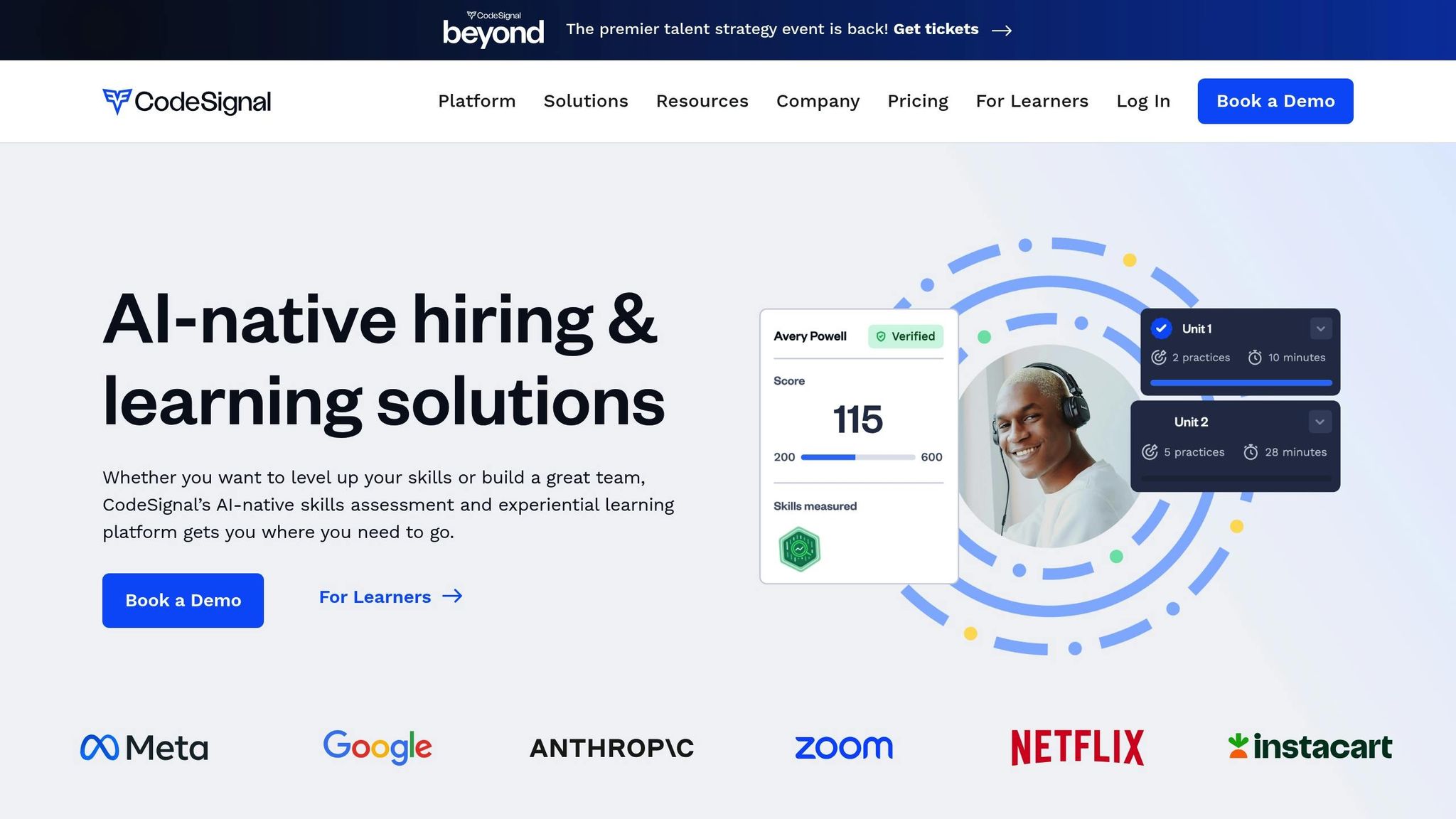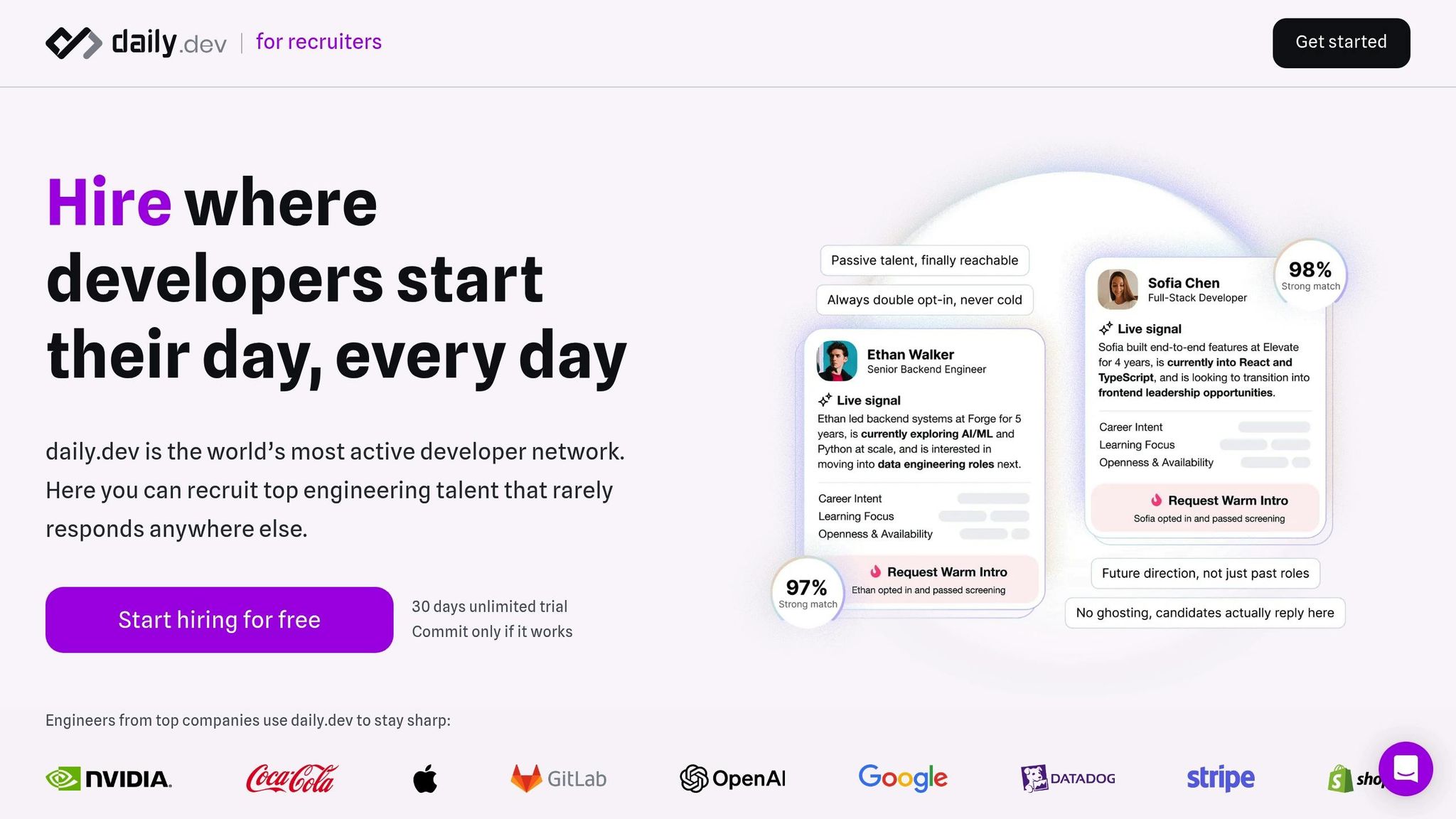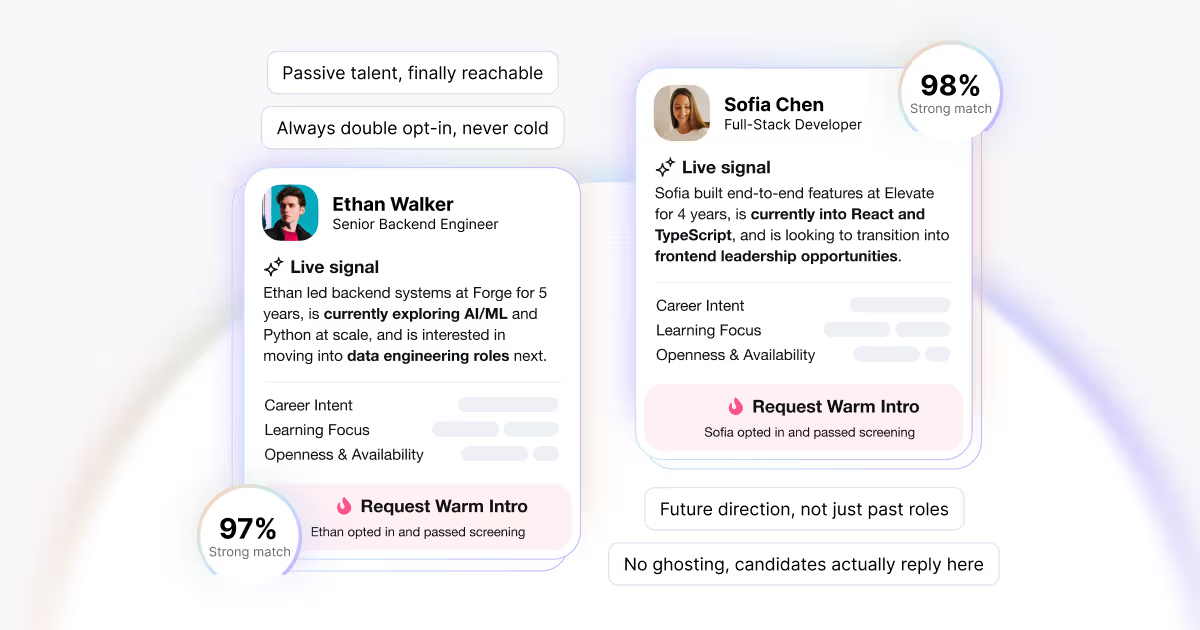


Pre-qualification transforms developer hiring by ensuring alignment between candidates and roles, boosting engagement, and building trust.
The current developer hiring process is broken - 90% of developers ignore traditional outreach, and ghosting is rampant. Why? Mass cold messages, vague job descriptions, and impersonal approaches have eroded trust.
Pre-qualification fixes this. It ensures candidates are screened for skills, interests, and fit before contact, leading to better matches, higher response rates (85–90%), and fewer wasted resources. Developers see full job details upfront and opt in only if interested, creating trust-driven, meaningful conversations.
Key takeaways:
- Problem: Developers disengage due to irrelevant outreach and unclear roles.
- Solution: Pre-qualification aligns expectations early, saving time and building trust.
- Result: Higher engagement, better matches, and a smoother hiring process.
Platforms like daily.dev Recruiter already use this method, connecting recruiters with engaged, pre-qualified developers for efficient hiring.
How CodeSignal Uses Pre-Screen to Hire Top Talent

What is Pre-Qualification in Developer Recruitment?
Pre-qualification is reshaping how developers are hired by shifting from broad, impersonal outreach to a more targeted and meaningful approach. Instead of relying on mass job postings and hoping for responses, this method creates a system built on trust and relevance. It connects employers with developers who are not only interested but also well-suited for the role. Here’s how it works:
Pre-Qualification Basics
At its core, pre-qualification ensures that candidates are screened for their skills, interests, and overall fit before any contact is made. This means that every conversation starts with clear alignment between the developer and the employer’s needs.
Opportunities are presented exclusively to developers whose skills, goals, and interests align with the role. Instead of broadcasting job openings to a wide audience, pre-qualification focuses on creating matches where both parties see immediate value.
One standout feature is its double opt-in process. Developers are given access to the full details of a role and can choose to engage if they’re genuinely interested. This eliminates much of the uncertainty and guesswork typically found in traditional hiring methods.
Main Pre-Qualification Criteria
Effective pre-qualification goes beyond surface-level screening by evaluating both technical expertise and professional alignment. This includes assessing:
- Technical skills: The foundation of any match.
- Current interests and passions: Ensuring the role aligns with what excites the candidate.
- Career goals and trajectory: Matching the role with the candidate’s long-term ambitions.
- Work history: Understanding the candidate’s professional background.
- Custom requirements: Specific needs defined by hiring managers, such as expertise in a particular framework, team collaboration style, or availability.
For instance, consider a backend engineer who thrives on working with distributed systems. A role focused on frontend maintenance might not align with their interests, even if they have the technical skills. Custom screening questions help clarify these nuances, ensuring that only candidates who are a true match move forward.
"Beyond CVs: see work history, current interests, and future aspirations to get the full story of every candidate."
– daily.dev Recruiter
Why Context Matters in Pre-Qualification
Providing full transparency from the start takes pre-qualification beyond simple filtering and turns it into a smarter matching process. When developers have access to detailed information - like team dynamics, growth potential, and daily responsibilities - they can make informed decisions about whether to engage.
Traditional hiring methods often hold back critical job details until later in the process. This can lead to mismatched expectations and wasted time for both the employer and the candidate. Pre-qualification flips this approach by offering transparency upfront, which builds trust early on.
This openness is particularly effective in attracting passive talent - developers who aren’t actively job hunting but might be tempted by the right opportunity. By offering clear and honest details from the beginning, pre-qualification leads to more meaningful and productive conversations, saving time and fostering stronger connections.
Problems with Standard Developer Sourcing Methods
Traditional approaches to hiring developers often fail to attract and engage the right talent. This creates a cycle of wasted effort, missed opportunities, and growing frustration between developers and recruiters.
Low Response Rates and Ghosting
One of the clearest signs of these shortcomings is the lack of responses and frequent ghosting. Cold outreach and generic job postings rarely grab developers' attention. For instance, 90% of developers in daily.dev's network don’t respond to outreach on traditional platforms. Nimrod Kramer from daily.dev explains: "Recruiting is broken because it burned trust". Developers have grown wary after being inundated with irrelevant, impersonal, and vague messages. When outreach fails to resonate, or when job roles don’t live up to expectations, developers are more likely to disengage, leaving recruiters stuck in a frustrating cycle of ghosting.
The root of the problem lies in outdated methods like mass emails and generic job ads, which treat developers as interchangeable instead of professionals with unique skills and goals. This approach makes developers feel like just another name on a list, reducing the likelihood of meaningful engagement.
Wasted Time and Resources
Conventional hiring practices can be incredibly inefficient, consuming both time and money. Recruiters often spend hours crafting outreach messages that go unanswered or screening candidates who aren't genuinely interested. This leads to repetitive and unproductive screening calls.
Reaching passive talent - developers who aren’t actively job hunting but might consider the right opportunity - is another major hurdle. Traditional job boards and sourcing methods fall short in connecting with this group, further compounding inefficiencies. Misaligned expectations between recruiters and hiring managers, such as unclear role requirements or mismatched priorities, only add to the wasted effort. These inefficiencies not only slow down the hiring process but also make it harder to establish trust with potential candidates.
Lack of Trust and Poor Matches
Building trust is crucial in developer hiring, but traditional methods often fall short in this area. The prevalence of "vague roles, fake jobs, and AI noise" has created a skeptical environment for developers. Impersonal approaches fail to account for a developer’s specific interests, career goals, or preferred technologies. Without this understanding, recruiters struggle to make meaningful connections or present roles that truly resonate.
Generic job postings that lack transparency further erode trust before conversations even begin. When job descriptions omit critical details about the role, team, or company culture, developers feel like they’re being sold a position rather than being offered a genuine opportunity. This lack of trust often leads to poor matches. Even when technical skills align, mismatches in work style, cultural fit, or long-term goals can surface late in the process, making the hiring experience feel transactional rather than relationship-driven.
To fix these issues, there’s a pressing need for a more personalized and transparent approach. Pre-qualifying candidates and aligning expectations early on can help both developers and recruiters avoid unnecessary guesswork, paving the way for stronger connections and better outcomes. A trust-driven process isn’t just a nice-to-have - it’s essential for successful developer hiring.
sbb-itb-d1e6221
How Pre-Qualification Fixes Developer Hiring Problems
Pre-qualification offers a smart solution to common hiring challenges by creating a more focused and efficient process. Instead of relying on broad outreach and hoping for responses, this method ensures targeted, trust-driven interactions that benefit both developers and recruiters. Let’s break down how it improves response rates, optimizes resource use, and fosters trust.
Better Response Rates and Less Ghosting
One standout advantage of pre-qualification is its ability to boost response rates significantly. By focusing on candidates whose skills, interests, and career goals align with the role, the process ensures that only genuinely interested developers are engaged. These candidates are pre-screened and introduced through a warm, double opt-in system. In this setup, developers review the opportunity beforehand and agree to the conversation, which drastically reduces the chances of ghosting.
"Yes. Because they choose to. Every introduction is double opt-in, which means the developer has already reviewed the role and agreed to the conversation. In early cohorts, reply rates consistently exceed 85–90%."
This targeted approach ensures that candidates are not only a good fit but also motivated to engage.
Better Resource Management
Pre-qualification doesn’t just improve engagement - it also saves time and resources. By showcasing roles only to developers who meet specific criteria, recruiters avoid wasting effort on unqualified candidates. This streamlined process allows recruiters to skip many initial screening calls, as candidates already receive detailed information about the role upfront. As a result, recruiters can dedicate their time to meaningful conversations rather than repetitive outreach. Additionally, automated applicant tracking systems help manage candidate information efficiently, enabling teams to focus on building relationships instead of administrative tasks.
Building Trust Through Warm Introductions
Establishing trust is essential in developer hiring, and pre-qualification helps foster it from the very first interaction. Developers are provided with complete, transparent details about the opportunity, empowering them to make informed decisions. These interactions occur on a trusted platform, which extends credibility to the hiring company as well. This trust-driven approach leads to higher-quality conversations and engagement. For example, 90% of the daily.dev network avoids replying to outreach on other platforms but actively engages here.
daily.dev Recruiter: Developer Hiring with Built-In Pre-Qualification

daily.dev Recruiter takes the guesswork out of hiring by connecting recruiters with a qualified pool of developers already active within the daily.dev community. Instead of relying on impersonal methods, the platform offers direct access to engaged professionals, paving the way for a hiring process rooted in trust and efficiency.
A Platform Tailored for Developers
daily.dev Recruiter is built on a professional network where developers spend their time staying informed, learning, and interacting with industry-specific content. This unique setup ensures that job opportunities are presented only to developers whose skills, interests, and career goals align with the role.
What sets this platform apart is its ability to reach "passive talent" - developers who aren’t actively searching for jobs but are open to the right opportunity. Since these professionals already trust daily.dev as a source for staying updated on tools and trends, the platform achieves engagement rates that far exceed those of traditional job boards.
"90% of the daily.dev network won't reply elsewhere, but they do reply on daily.dev".
Transparent, Mutual Introductions
The platform's double opt-in system ensures clarity from the start. Developers see full job details upfront, allowing them to decide if the role aligns with their expectations before any conversation begins. This transparency encourages developers to self-qualify, saving time for both parties.
The process involves several layers of pre-qualification. Developers who express interest in a role are first evaluated against the recruiter’s criteria. They then answer up to three custom screening questions, designed to confirm their suitability for the job and the hiring manager's specific needs. Only after these steps are completed does the recruiter connect with the candidate.
This structured approach eliminates the inefficiencies of cold outreach. Developers engage because they see real value, and recruiters can trust that they’re speaking with interested, pre-qualified candidates. The result? A smoother, more productive hiring experience.
A Streamlined Recruitment Process
daily.dev Recruiter simplifies hiring by cutting out the need for time-consuming outreach and initial screening calls. Developers receive all the job details upfront, allowing recruiters to dive straight into meaningful conversations with candidates who are already pre-qualified.
Unlike traditional platforms that offer a database of profiles requiring manual outreach, daily.dev Recruiter delivers warm introductions to developers already engaged on the platform. This approach transforms the hiring process into a fast, efficient, and high-quality experience.
"Most platforms give you a database of profiles. With daily.dev, you get warm, double opt-in introductions from developers already engaged on our platform. It's a distribution channel powered by developer attention, not another search tool".
This innovative process is especially effective for connecting with senior developers and engineering leaders - professionals who often ignore traditional outreach methods. By focusing on genuine engagement, daily.dev Recruiter ensures recruiters can make meaningful connections without the usual hurdles.
Conclusion: Why Pre-Qualification Works for Developer Hiring
Pre-qualification reshapes how developers are hired by moving away from impersonal outreach and focusing on transparent, trust-based connections. This approach ensures candidates are presented with opportunities that genuinely match their skills and interests, setting a new standard for recruitment.
The shift from cold outreach to trust-driven matchmaking isn’t just a strategy - it acknowledges that trust is the cornerstone of effective recruiting. Traditional methods often undermine this trust with vague job postings, irrelevant roles, and impersonal mass emails. Pre-qualification restores confidence by offering developers transparency, control, and a personalized experience. It directly addresses the issues that lead to ghosting and wasted resources.
For example, reply rates for double opt-in introductions on daily.dev Recruiter regularly surpass 85–90% in early cohorts. This high engagement happens because of mutual intent - both recruiters and developers see value in the connection before entering into a conversation.
Developers are selective about the opportunities they pursue. Pre-qualification ensures that every introduction feels relevant, contextual, and voluntary, creating the ideal environment for meaningful engagement.
These results highlight that pre-qualification isn’t just helpful - it’s crucial for building effective, long-term hiring relationships. The old "spray-and-pray" approach wastes time and can harm employer reputations. By focusing on trust-driven recruitment, which values developer experience and mutual alignment, companies can find better candidates faster while fostering relationships that last beyond a single hire.
daily.dev Recruiter bridges the gap by connecting recruiters with engaged developers through warm, double opt-in introductions. By embedding recruitment into a professional network where developers already spend their time, the platform naturally delivers outstanding hiring outcomes.
FAQs
How does pre-qualification help reduce ghosting and improve response rates in developer hiring?
Pre-qualification streamlines the developer hiring process by connecting employers with developers who are genuinely interested in engaging. Using a double opt-in process, developers actively confirm their willingness to be contacted. This simple step helps cut down on ghosting and boosts response rates.
By focusing on meaningful, trust-based interactions, this method saves time for both recruiters and developers. It also encourages clearer communication and builds stronger professional relationships.
What criteria are used to pre-qualify developers for job opportunities?
When assessing developers, the focus is on their technical expertise, current passions, and future career aspirations. To refine the selection process, candidates also answer up to three customized screening questions. These questions are designed to ensure their skills and interests align closely with the role. This thoughtful approach not only identifies candidates who are a great fit but also streamlines the hiring process, making it more effective and purposeful.
Why is transparency important in pre-qualifying developers, and how does it benefit both parties?
Transparency in the pre-qualification process plays a crucial role in establishing trust and ensuring expectations are aligned between developers and recruiters. By offering developers clear and detailed insights about a role right from the start, they can decide if the opportunity matches their goals and preferences.
For recruiters, this approach means focusing their efforts on developers who are both genuinely interested and appropriately qualified. This not only saves time by minimizing mismatches but also boosts response rates. A trust-centered process like this leads to a more efficient hiring experience and stronger connections for everyone involved.






